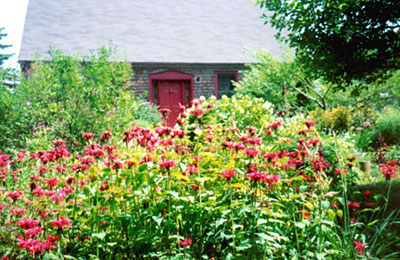 |
| This is the house that Eric Evans built, with bee balm gracing the dooryard. English photo. |
American Chestnuts, Daylilies, Vegetables and Friends
By Jean English
Laura and Eric Evans seem to have lived a life comprised of one fascinating project after another. The community garden – or, more accurately, community of friends garden – that they started on their land in Camden last year is no exception.
Garden member and professional photographer and artist Dorie Klein explains the garden’s beginnings: “Last year many of us were part of an [ethnic] dance group that met every Sunday night and danced for three hours, week after week, month after month, and really had a wonderful time. It was kind of our social thing to do. We aren’t doing the dancing this year, so one of the things that still brings us together socially is the garden.”
“We know each other in a lot of different ways,” adds Laura. “A lot of us were gardeners that wanted to garden but had small, shady lots or no room, and we [she and Eric] had this area that we had cleared…”
So the garden planning began in February of 2002. In addition to the Evanses and Klein and her husband, Dana Strout, a lawyer and also a photographer, other members include landscaper, daylily breeder and grower, masseuse and caterer Susan Shaw and her husband, Paul Cartwright, a structural engineer, sculptor and member of the Camden select board; homeopath Dee Webster and her husband Dave Miramant, a pilot and member of the Camden select board; Jenni Cantlin, who works for MBNA; realtor Susan Dorr, another Camden selectperson, and her husband Greg Dorr, the city attorney for Rockland. Some of these people knew about and were inspired by a similar community garden project on land owned by Judy Berk and David Foley in Northport, Maine.
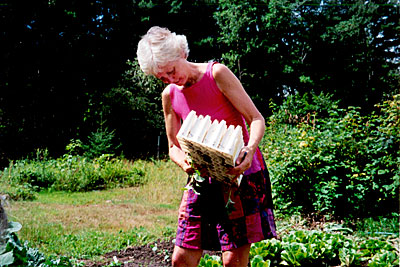 |
| Dee Webster removes vegetable seedlings from a tray that once grew tree seedlings. |
The 7000-square-foot garden includes an upper part that the Evanses have cultivated for years, and the newly cleared, larger, lower garden. To fertilize the latter, they borrowed a tractor, rototilled the soil, and tilled in compost, wood ashes, rock powders and two dump truck loads of cow manure. They planted heat-loving crops there rather late, after the cold, rainy spring in ’02, and by midsummer it was producing “just gobs” of green beans and other crops that were “looking quite good,” as Laura describes them.
Early crops went in the upper garden – onions, strawberries, asparagus, beets and lettuce in one part, potatoes and carrots in another. Eliot Coleman’s method of setting four onion transplants or sets in one hole was proving itself here as in others’ gardens: “It makes it so much easier to start and transplant and weed” the crop, says Eric.
On this early August Sunday morning, all of the garden members are present, mostly pulling weeds from some crop rows and smothering weeds in other areas with cardboard topped with pulled weeds. Sometimes they’ll rototill around a garden area to keep weeds from creeping in; other times, to avoid bringing the tiller up to the garden, they’ll use cardboard.
These work sessions are easily organized. “Word gets around,” says Eric, “and everyone comes together because they like to gab. Generally people come for a two- to three-hour gardening session either Saturday or Sunday morning, and most come at least one day during the week to harvest things and do a little weeding. We don’t have any systematic harvest,” Eric continues. Instead, members take what they want, when they want, because “there’s way more than needed.” A row of raspberries provides fresh fruit for snacking while these friends work in the garden. Much of the strawberry harvest also went for snacks, although they did have some strawberry shortcake as well.
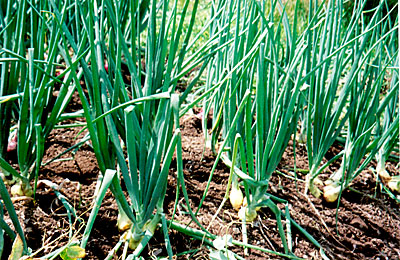 |
| Onions are grown in groups of four to simplify seeding, transplanting, weeding and harvesting. |
Favorite Varieties
Among the favorite varieties here are Sierra lettuce from Fedco, which is “good from the very beginning and lasts a long time into summer,” says Eric. While the other lettuce varieties were bitter and/or bolting by early August, Sierra was still good. A second crop of lettuce, planted around mid-June, was almost ready to harvest.
Red Russian has been the standard garlic variety grown, but Eric is pleased with the better storage capability of other varieties, such as Bogatys, German Extra Hardy and Romanian Red, that he bought from Mark Fulford of Monroe at the Common Ground Country Fair a couple of years ago. Bulbs of these varieties usually have four or five cloves that are larger than those of Red Russian, which usually has six to nine cloves per bulb.
A tiny planting of artichokes was started at the same time as onion seedlings in the Evanses’ house, then hardened off in their hoop house before being planted in the garden. Eric jokes that the harvest will be enough for each garden member to have one leaf.
Favorite onion varieties include Ailsa Craig, Copra, the big, red Greek Salad, and Mars, a red storage onion that is fairly recent. Beans include Provider bush beans and, for pole beans, Northeaster, Fortex, Rattlesnake and Jeminez. Envy soybeans from Johnny’s Selected Seeds are eaten green and are easily frozen for winter eating after blanching them in the shell. Taken out of the freezer, “you can microwave them and pop them out of the shell,” says Laura. Some are grown to maturity, then hung upside down to dry in order to produce seed for subsequent crops.
Melons are grown on IRT (infrared transmissible) mulch. “I believe that if you want melons, you have to do certain things, especially here along the coast,” Eric explains, referring to the mulch. “Earlidew usually gives us some pretty good melons.”
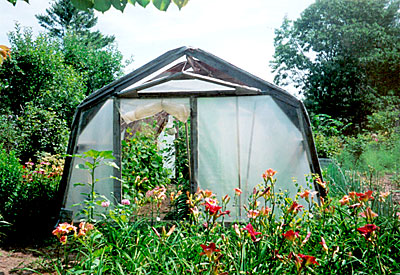 |
| A small greenhouse where seedlings are hardened off and tomatoes and cucumbers grow in summer. |
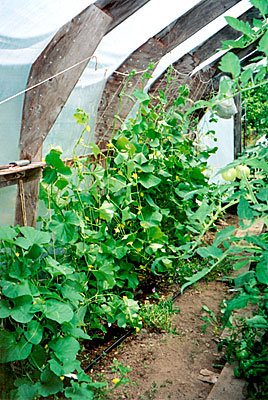 |
Squashes include Delicata, Buttercup, Butternut and Acorn. Early Yellow Crookneck summer squash “has so much more flavor and character than the others,” Eric continues. And for sweet corn, they started Spring Treat and Silver Queen in 6-inch-deep tree plug trays and transplanted it, while Kandy Plus and Bravado were direct-seeded the first week in June. Interestingly, Kandy Plus did not germinate well during that cool, wet time, but Bravado did.
Favorite tomatoes include Sun Gold and Sun Sugar. For peppers, they always grow Ace, although Eric describes it as “thin skinned” and not great; “There’s just a good chance they’ll set fruit when nothing else does.” Fat ’n Sassy, however, has “really heavy” fruits compared with Ace. Valencia, Purple, Chocolate and Amish pimento peppers are also growing. Regarding eggplant and pepper plants, Eric says, “It’s really true that if you don’t keep them growing vigorously, if they get set back, they don’t recover.” Drip and sprinkler irrigation help crops grow steadily here.
An abundance of fruits also grows on the Evanses’ land. Some 14-year-old kiwi vines yield heavily and, says Eric, are “just as easy to propagate as grapes: Prune them in spring, take a cutting in spring, keep it in the refrigerator until the ground thaws, then in the greenhouse put down a piece of black plastic and punch a hole with a broomstick in it, dip the cutting in a rooting hormone, stick it through the hole in the black plastic, and firm the soil around it.” Every one of the cuttings he started this way “is growing like crazy now.”
Highbush blueberries are productive, and fruits are protected from birds by covering some bushes with netting and by hanging junk-mailed America Online computer disks in other bushes. Laura glued two disks together so that the reflective side showed on both sides of the end product.
The Evanses also grow grapes, which Eric plans to train on a 5-foot-high steel wire stretched along posts set between the vines. Apples, apricots, peaches and plums also populate the 6-acre lot, and from these plantings Eric and Laura “have determined that plum curculios will infest anything with a smooth skin, and they don’t touch peaches at all. So we think peaches are really terrific – they taste good, they’re juicy, they bear abundantly, and you don’t have to spray them.” They thought their apricots may have foiled the cucurlio, but ended up showing damage when they were grape-sized, apparently not having “enough furriness to deter the curculio.” This pest can be controlled with regular sprays of the kaolin-clay preparation Surround. “Last year we sprayed [our plum tree] with Surround quite a bit,” says Eric, “and we got a nice crop of plums – except for hail damage. Surround really does work, but you may have to spray every week, starting at blossom time, depending on how much it rains.”
Among the nuts growing on their property are American chestnuts, Chinese chestnuts, heartnuts and chinquapins – a “little bushy cousin” of the American chestnut, with smaller, sweeter seeds than the latter and with hulls that are furry rather than prickly. Eric doesn’t think that the chinquapin would reproduce well on its own in Maine, because the seeds germinate as soon as they ripen in the fall and probably would not survive winter in Maine. His trees came from Empire Nursery in Ohio. [Visit the Empire Chestnut Company website.]
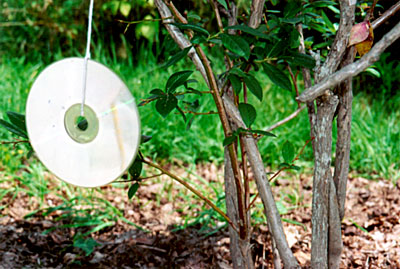 |
| Birds are frightened from highbush blueberry bushes by junk mailed AOL disks, two glued together to form one that is reflective on both sides; or the birds are deterred by netting. |
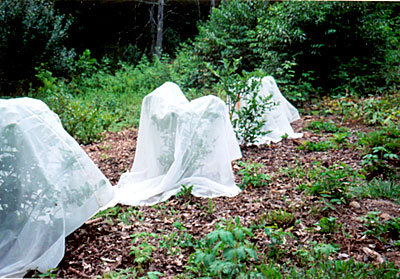 |
The Long Road to Camden
The Evanses’ home and highly productive gardens, on the site of what was once, ironically, Camden’s poor farm, have provided a long-term stop in the circuitous highway of life that the couple has followed. Laura, originally from Massachusetts, finished high school at Waynflete in Portland, visiting her aunt and uncle in Camden that year as well, and loving the area. She met Eric at college in Ohio, his home state. When Eric enrolled in a Ph.D. program in biology at Stanford, they moved to California, but Eric’s graduate program was interrupted by the Vietnam war. After a year of study, he had earned his Master’s degree, but dropped out of the Ph.D. program and quickly got a teaching certificate and a job teaching junior-high biology to avoid the draft. Two years later, when he was 26 and no longer draftable, he quit teaching.
Laura pursued environmental studies at San Jose State. “We were very into organic agriculture, even then,” says Laura. “We had a lot of gardens, chickens, goats – mostly in San Martin, an agricultural area.” They rented a little house with pasture land, a barn and a supply of manure, which fertilized the 14-foot-deep, rock-free soil. Growing conditions were almost perfect – ”but it doesn’t rain there. You have to irrigate constantly.” Also, the price of land was very high but not high enough to deter “ripping it up and making housing developments and channelizing creeks and putting in roads, six-lane highways.”
Laura, finding the environmental degradation of the area “too hard,” says that she “remembered how lovely Camden was, and we decided to come back here.” They packed their belongings – including a horse and goats – and pulled their horse trailer across the country, calling campsites ahead as they went and asking whether they had fields available away from the general campground. “Usually after four or five calls, we would find someone who would say, ‘Sure.’ We camped in some really cool places and [met] people who liked horses, and they’d help us find hay.” Arriving in Camden, they camped and pastured their animals on their aunt and uncle’s lawn until they found cheap land in Appleton.
As Appleton homesteaders, they were active in MOFGA, both in the Upper Knox Chapter and in the state organization. Laura served on the board and remembers voting in Chaitanya York as the organization’s first executive director; and making “a humongous fish chowder to feed the volunteers” at the first Fair.
When they had their first two children (a third arrived nine years later), they “soon figured out we needed a little income.” So Eric worked in the Biomedical Department of Marine Colloids, developing biological tests for diseases, while Laura stayed home with the kids, garden and goats. “After my initial bout of homesteading and childrearing,” says Laura, she went to nursing school and worked nights. Eric went on to work in general construction for 10 years, adding to his skills that are apparent in the beautiful, owner-built home in Camden where the Evanses moved 16 years ago. In 1990, Eric went to work for Woods End Lab in Mount Vernon, Maine, where, among other projects, he followed through on owner Will Brinton’s idea and developed a test kit to measure the maturity of compost.
Laura next became self-employed in order to be home with her third child, Ben, while he was little. She made cookies for Morgan’s Mills in Union; made teddy bears and dolls; and wrote for the Camden Herald. “I had four or five different operations going at once,” she says. “The cookies kept selling, so I kept making more and more cookies. They sold faster than dolls and teddy bears. So I wound up … getting a shop with a partner and doing cookies down on the [Camden] waterfront, and then I bought out my partner. The landlord offered me more space, so I did the restaurant for three years before becoming totally exhausted.” That was followed by running her own temporary staffing service for four years, running job fairs for a year, then deciding “to retire and become employed by someone else.” She now works in a group home for mentally ill people and does part-time nursing.
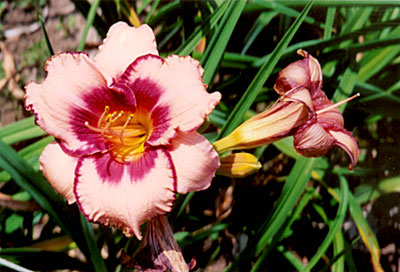 |
| Pink petals with a purple ruffle, purple center and yellow throat—this is one of the striking daylilies that Laura Evans has bred and is watching for growth habit and pest resistance. |
Developing Daylilies
One of the signs that the Evanses have passed those busy, early-middle-age, childrearing, job-changing years is the planting of daylilies that Laura not only cultivates but breeds. “I’m breeding for pretty flowers, sturdy plants with lots of buds, and I’m trying to get something that will have a nice flower in this climate,” she explains. “Some flowers bred in Florida just won’t open here. They need more heat or something. Some are so susceptible to thrips – the flowers are mutilated with little spots all over them. I think there must be some resistance to thrips, because some flowers are just perfect, so I select for those.” She also looks for interesting flowers with a variety of colors, such as a bi-tone one with purple, ruffled petals and peach sepals; with “something like a water mark, a paler area in the center;” and with a green throat, “which is desirable. This is an interesting flower. It’s got a lot of different things happening to it.”
Another favorite is peach with a raspberry eye and raspberry edge, with ruffled petals, her “most successful cross so far and maybe my most marketable flower eventually. I have to see how it does when it has more room and can grow into a clump.” She marks the ones she wants to look at further with colored tape around the bottom or around the flower stem, writing the parentage and desirable qualities on the tape. Less desirable, “homely or thrip-eaten” plants have their flower stalks broken and bent over, and when Laura happens to be nearby with a shovel, she’ll dig them and toss them into the compost.
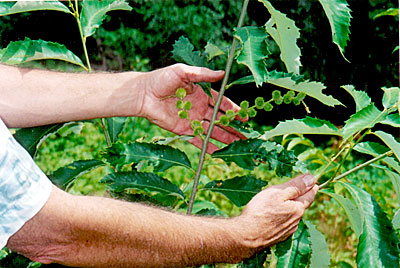 |
| A chinquapin oak, one of many fruit and nut trees planted by Eric. |
Breeding daylilies is not that difficult, Laura says. They don’t self-pollinate naturally. “The stigma is way up above the anthers. It is insect pollinated, but that naturally doesn’t happen too often. So if you take an anther from [one] flower and smear [the pollen] across that stigma in the morning – like 9 a.m. – it has all day to grow down and create seeds. Even if a bumble bee came along and scattered another kind of pollen on there, the predominant ‘dose’ is what you gave it.” After four years of making such crosses, she has so many plants to observe now that she’s taking a year off from crossing. “Also, I need to prepare more ground.”
Laura and fellow gardener Susan Shaw both got enthusiastic about daylilies at about the same time and started attending daylily functions to learn more. Shaw now has some 500 varieties, some used on her landscaping jobs, some sold to other gardeners. “She knows their names and their parents’ names and their genetics,” Laura says, amazed. (Shaw has an open house at her home on Mill St. in Camden during the third and fourth weekends of July, when she sells her daylilies. She can be reached at 236-4085 to arrange other dates or for more information.) Laura, more of a hobbyist, has about 30 varieties. She notes the fragrance of one variety. “When you have a whole clump of them, they make a pretty smell.”
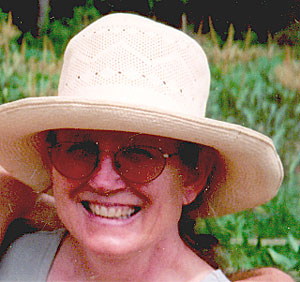 |
| Laura Evans. |
Third-World, Microcredit Connection
Sometime after the cookie stage and during the daylily breeding, Laura became the International Chairman for Camden Rotary, instigating microcredit programs in Ecuador. “We tried to get it done in one year, but it has taken awhile to get all the funding and get it together. We’ve got five banks started in a town in Ecuador.” She and two other women on the committee went to Ecuador to research the project. Then Rotary raised and granted some money, and advertised through Ecuadorian schools that they were forming a microcredit bank. Parents of the schoolchildren, usually women, would get together, elect a president, treasurer and secretary, learn the basics of business practices and formulate business plans. “By the time they’d done all this,” says Laura, “generally the money was raised. We were there to inaugurate a new bank, and we got to hand out the first checks. We loan them about $60 to start – about two months’ pay in Ecuador. One, whose husband was a shoe repairman, opened a shoe store within his shop to sell new shoes … simple sandals for $4 or $5 a pair. It was a nice adjunct to her husband’s business. The loan enabled her to get inventory and have a little showcase.” Another opened a little bamboo-sided, thatched-roof restaurant with the only TV in town. The husband cooked and she waitressed. “People would go there to see the news.” Others opened little stores to sell essentials, “a benefit for the whole community; they didn’t have to travel on the bus for miles.”
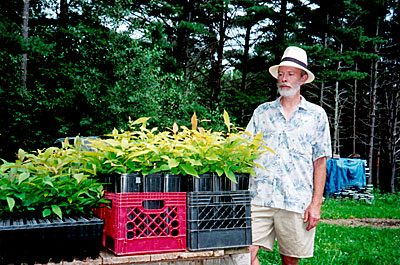 |
| The Maine chapter of the American Chestnut Foundation is selling chestnut seedlings to raise funds for its programs. Eric also is looking for people who are willing to plant 50 or 100 American chestnut trees on their property and monitor their performance. |
One particular community was near a dump. “I think the community had originally grown up as dump pickers. They organized a recycling business. They got bundled cardboard and things like that and sold it. It was a real benefit. That community ended up having a little daycare center. Rotary Club supported some simple concrete block housing and supported them in other projects, too.”
Reviving American Chestnuts – Six Acres and Dependence
Just as being rooted in one area for many years and connecting with neighbor Susan Shaw prompted Laura’s interest in daylilies, Eric has been able to come full circle with his interest in the American chestnut because of the couple’s 6 acres of land and connection with area residents. “I first noticed and learned about the decline of chestnuts when I was camping with the Boy Scouts in the Blue Ridge Mountains in Virginia when I was fifteen,” says Eric. “I was always interested in tree identification. There were resprouting stumps of chestnuts near the camp we were staying in. I read about blight in my tree book. This was in the late ’50s, so it was still kind of new.” Despite the relative newness of the outbreak, Eric was surprised to see, already, “arrow straight trunks of trees in the woods that had died. It really made an impression on me.”
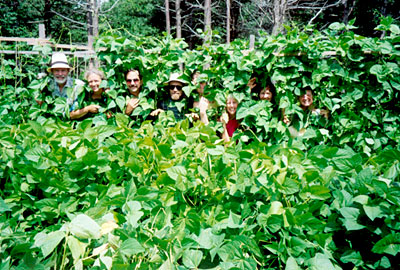 |
| Bean there, grew that: Among the members of this community garden are, left to right, Eric Evans, Susan Shaw, Dave Miramant, Steve Cartwright, Jenni Cantlin, Dee Webster, Dorie Klein and Laura Evans. |
In 1995, he saw an article in the Camden Herald describing area resident Wells Thurber’s efforts to pollinate American chestnuts in Knox County. “It clicked, because I had this thing in my memory since I was a teenager. I called him, and we got together.” Eric has since become deeply involved in pollinating and selecting American chestnuts, raising seedlings and transplanting trees; so involved that he is now president of the 180-member Maine chapter of the American Chestnut Foundation – formed after the Ice Storm of 1998 in order to speed progress with that tree after remaining specimens were badly damaged.
Eric is like a walking computer disk of information about the American chestnut and strategies for breeding resistance to chestnut blight – so much so that this will be the subject of a separate article in a future issue of The Maine Organic Farmer & Gardener. For now, though, readers should know that the Maine chapter has thousands of chestnut seedlings – some contract-grown by Western Maine Nurseries in Fryeburg and by Bob Vanderventer of Unity; some grown free at International Paper’s greenhouse in Hermon – to be sold to raise funds for further breeding and cultural studies of the tree and the disease. Also, the Maine chapter is looking for people who would be willing to plant lots of 50 or 100 trees, provided free by the chapter to growers who will keep careful records of their performance. For more information about the Foundation, contact Eric Evans at 236-9635.
